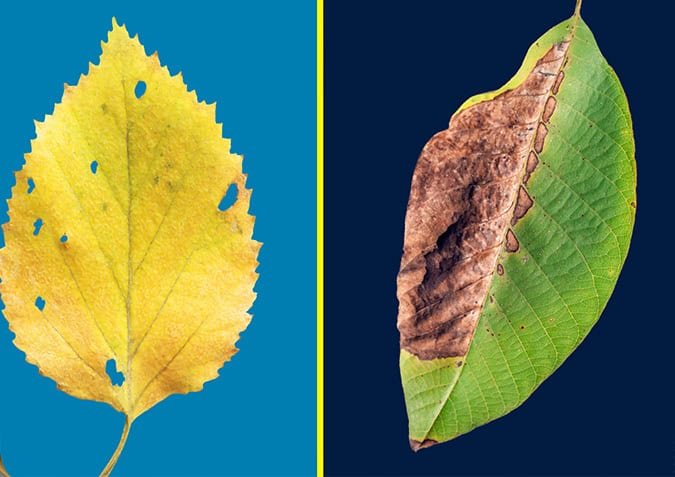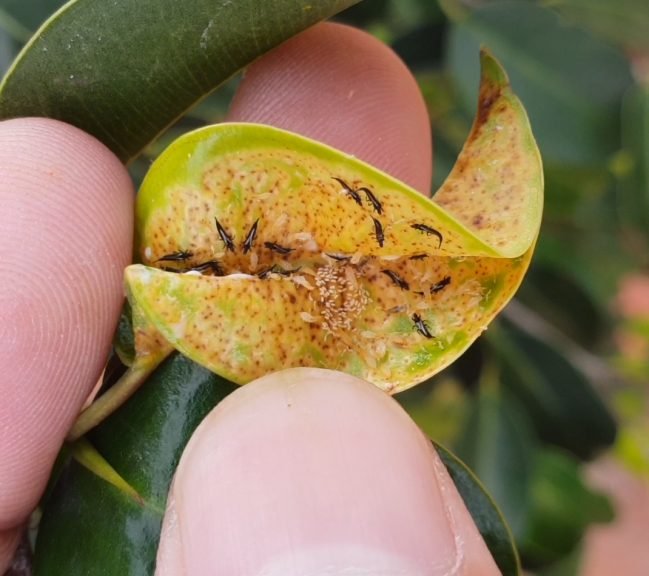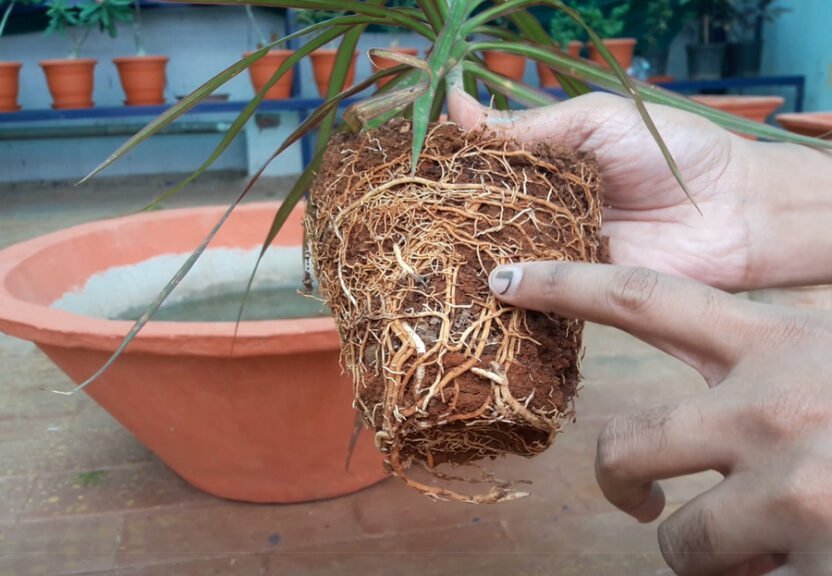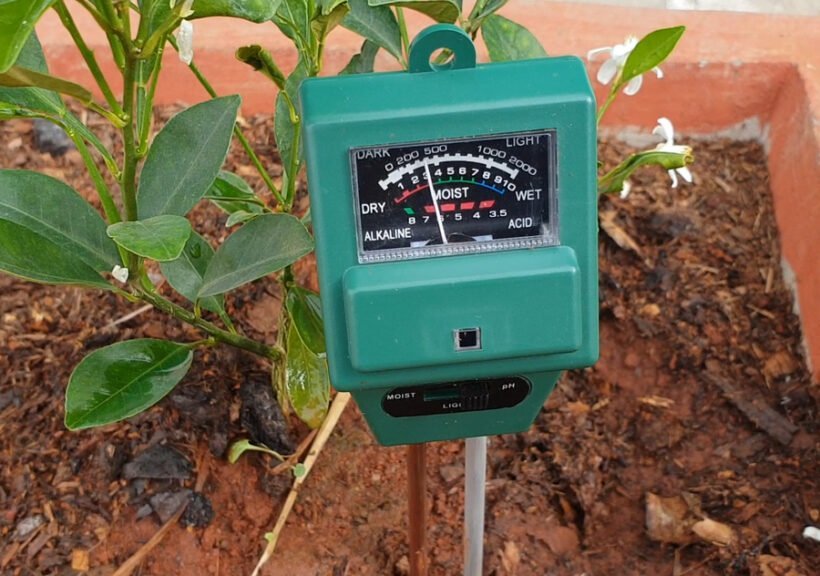Contents
In today’s post, we will look into top 10 reasons for leaf yellowing and leaf browning or burning at tips and edges along with the solutions and will also show you few related simple gardening tricks and hacks to treat these problems.

Introduction
When you see leaves turning yellow or burning or browning at it tips or edges, it’s time to investigate and find out the possible cause and solution to it. You must be aware of these problems to keep your plants stress-free and healthy! The first broad diagnosis for leaf yellowing that should come to your mind is – YOUR PLANT IS IN STRESS, and then you further start investigating and finding out the exact reason for this problem. We will start listing the top 10 reasons for leaf yellowing and leaf browning in descending order.
Top 10 Reasons for Plant Stress
10. Natural Aging of the Plant
This is one obvious reason for yellow leaves. If you see older leaves especially at the bottom of the plant turning yellow, just ignore it. This is not a reason to worry.
9. Pest Attacks

Sucking pests like aphids, mealybugs, whiteflies, thrips, and mites can damage the leaves and can cause yellowing of leaves. Prevention is better than cure. These can be easily prevented or even treated organically using Neem oil spray regularly for treatment as well as prevention. Spray neem oil once every 15 days as a preventive measure and weekly once or even twice for treatment of these pests. You can check my detailed post on NEEM OIL.
8. Root Bound Plants

“Root bound” plant means that the roots of a plant have completely taken up the space within the pot, often circling and creating a dense web of roots. This can stress the plant and deprive it of nutrients, air, and water and this can result in leaf yellowing and stunted growth of the plant. Just repot the plant in a larger container or carefully perform root pruning if you wish to use the same container.
7. Transplant Shock
This is another reason for leaf yellowing and leaf drop. This is the period of stress to the plant when you just repot a plant. You can solve this to a certain extent by repotting your plant carefully and after repotting for the next one week keep the plant in shade away from direct sunlight. Water the plant once thoroughly with Epsom salt solution to counter this transplant shock. 5 to 10 grams of Epsom salt per liter of water is the recommended dosage. You can watch my detailed video on the 10 golden rules of Repotting a plant.
6. Fertilizer Overuse
If you observe a strange pattern to yellowing of leaves, like if the veins on the leaves are green and the tissue is getting yellow or the edges or tips are yellow or looking like burnt along with bud drop off or fruit drop off, then it is mostly due to fertilizer misuse. Commonly, overuse of fertilizers is the problem, so it is important to use fertilizer at the recommended dosage. This problem is more common with the use of chemical fertilizers like Urea, DAP or NPK granules and not a problem with organic fertilizers. Moreover, people tend to use too much fertilizer on their plants to make them grow faster, especially newbie gardeners. But what it actually does is, it creates a toxic effect on the plant which “burns” the leaves and turns them yellow.
5. High Soil pH – Too Alkaline Soil

This can also be one of the reasons for leaves turning yellow. This is little difficult to diagnose unless you have a soil pH testing gadget. This simple pH testing gadget will give you a rough idea about the soil pH whether acidic or alkaline soil. Most plants need a slightly acidic pH of around 6.5 for best absorption of nutrients.
4. Temperature
Leaves start turning yellow when it is either too hot or too cold. In terms of the cold temperatures, like for example adenium plants, the leaves start yellowing in winter and eventually fall off and the plant goes into the dormant state in winter. That’s called Winter Dormancy and applies to many other plants as well.
3. Sunlight
Reduced exposure to light is another common reason for plant leaves to turn yellow because not enough light is reaching the plant for photosynthesis. Similarly, too much exposure to hot direct sun is another common reason for tips and edges of leaves to turn dry and brown. This can be corrected easily by knowing your plant by its name or at least whether it’s a sun-loving plant or a shade-loving plant. Knowing a plant by its name is very important to learn about its care tips especially its light requirement and provide optimum exposure to sunlight. A simple free app to know a plant ID is Google Lens app provided by Google. You can watch my detailed episode on GOOGLE LENS.
2. Improper Watering
Improper watering can present as either leaf yellowing or leaf drying or leaf burning at tips and edges. The most common reason that plants’ leaves turn yellow is because of moisture stress, which can be from either overwatering or underwatering. Similarly, the most common cause for brown leaf tips or brown edges on leaves is the plant not getting enough water, which can be due to several reasons apart from you not watering the plant adequately.
First of all, check whether you are adequately watering the plant by checking the soil surface for moisture by dipping one or two inches of your finger. If you are forgetting to water the plant, rectify this problem immediately, especially for water-loving plants. But this does not mean you have to overwater them which is actually more dangerous than underwatering and can result in root rot.
The roots may be constricted and unable to pick up or absorb the water adequately, especially in container gardening. Also, too much clay-rich soil is another cause of constricting the roots tightly. So increasing watering to resolve this issue is not the solution because there is a possibility of root rot with overwatering. Hence, the best solution to this is to repot the plant in a larger container and in a loose well-draining soil. A simple hack to get rid of clayey soil while repotting your plant is to soak the clay-rich root ball for a few minutes in a bucket of water to dissolve this soil and then repot this in well-draining soil.
The soil does not hold the water and drains out too quickly. If your soil is too much sandy or over-draining soil with a lot of sand, the water may simply be draining away too fast and this may be causing water deficiency and brown edges on leaves. Improve the soil with other stuff like organic material and mixing some garden soil and other stuff like cocopeat, perlite, vermiculite, etc which will hold onto the water better. An ideal well-draining soil is the one which drains out neither too quickly nor too slowly. A simple and rough test to check whether your soil is perfectly well-draining is when you thoroughly water your plant, it should drain out from the drainage hole in about 1 to 2 minutes, neither quicker nor too late.
The roots may be damaged. Like while digging or even repotting or too much root pruning of a root-bound plant, this can cause root damage and reduced water uptake. In this case, correct the problem that is causing the root damage and then do some good pruning on the plant branches to reduce its water requirement so that the root system recovers from this stress.
The fifth reason for the sides of a leaf to turn brown is a high salt content in the soil either using hard water (salty water) to water the plants or overuse of fertilizers. To overcome this, start watering with soft water and also if over-fertilized, flush the pot with large amounts of soft water keeping it in sunlight and properly opening the drainage holes of the container, so that the salty water or the fertilizer flushes out easily out of the pot.
One Simple Common Sense Hint for Watering
Generally, indoor plants are more prone to overwatering and outdoor plants are more prone to underwatering.
Leaf Chlorosis due to Nutritional Deficiencies
Leaf Chlorosis due to Nutritional deficiencies, either due to poor quality potting soil or absorption issues due to improper soil PH. Lack of uptake of major and minor nutrients in the plant like nitrogen and also certain mineral deficiencies like iron, manganese, zinc and other can cause unique leaf yellowing patterns. You can read my detailed post on diagnosing these various patterns of leaf yellowing due to nutritional deficiency.
Please Watch a detailed video tutorial explaining the Reasons for Leaves yellowing below:
